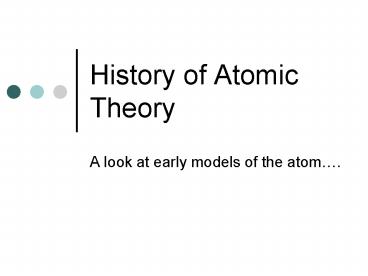History of Atomic Theory - PowerPoint PPT Presentation
1 / 16
Title:
History of Atomic Theory
Description:
History of Atomic Theory A look at early models of the atom . Historical Timeline Scientist Theory Time Published Democritus Atoms are completely solid 400 BC ... – PowerPoint PPT presentation
Number of Views:301
Avg rating:3.0/5.0
Title: History of Atomic Theory
1
History of Atomic Theory
- A look at early models of the atom.
2
Historical Timeline
Scientist Theory Time Published
Democritus Atoms are completely solid 400 BC
Dalton Billiard 1803
Thomson Plum Pudding (Introduction of the electron) 1906
Rutherford Planetary Model 1909 1911
Bohr Electron Shell Theory 1913
Schroedinger Quantum Physics and the wave model 1926
Chadwick Discovered the Neutron (1932)
3
Democritus Model (403 BC)
- 1. All matter is composed of atoms, which are too
small to be seen. These atoms CANNOT be further
split into smaller portions. - 2. There is no void, which is empty space between
atoms. - 3. Atoms are completely solid.
- 4. Atoms are homogenous, no internal structure.
- 5. Atoms are different in their size, their
shapes, and weight.
4
Democritus Model (403 BC)
5
Dalton Model (1803)
- 1.Each element was composed of the same kind of
atom. - 2. Elements of a given substance have atoms
composed of the same mass, size, and shape. - 3. Atoms form compounds in ratios (11, 12,
etc.). - 4. Chemical reactions are rearrangements of atoms.
6
Dalton Model of 1803 (Billiard Ball Model)
7
Dalton prepared one of the first Periodic Tables
of Elements using atomic symbol to represent
certain elements.
8
Thomson Model of 1906 (Plum Pudding Model)
- 1. The atom was divisible.
- 2. The atom consisted of both positively and
negatively charged material.
9
Thomson Model of 1906 (Plum Pudding Model)
10
Rutherfords Atom Model Conclusions
- The atom contains a small dense center called the
nucleus. - The nucleus contains most of the mass of the
atom. - The nucleus is positively charged.
- The atom is mostly empty space and the electrons
move around in this empty space.
11
Nucleus
12
Electron shells Bohr (1913)- The area in which
electrons are orbiting around the nucleus
- Each electron shell can only hold a certain
number of electrons. Once the shell is
filled, the next outer shell begins to get
filled.
13
Electron Shell Theory
- 1st shell holds 2 electrons
- 2nd shell holds 8 electrons
- 3rd shell holds 8 electrons
- 4th shell holds 18 electrons
- 5th shell holds 18 electrons
- 6th and 7th hold 32 electrons
14
Wave Model Schroedinger (1920s)
- Electrons are in orbitals (energy levels) around
the nucleus but dont rotate around the nucleus
like planets around the sun - The orbitals are really energy levels
- Bigger energy level higher energy
Lower energy
Higher energy
Highest energy of the three
15
Schroedinger - 1926
- Electrons can change orbits (energy levels)
- They give off or absorb electromagnetic radiation
as a photon when they change levels
16
(No Transcript)































